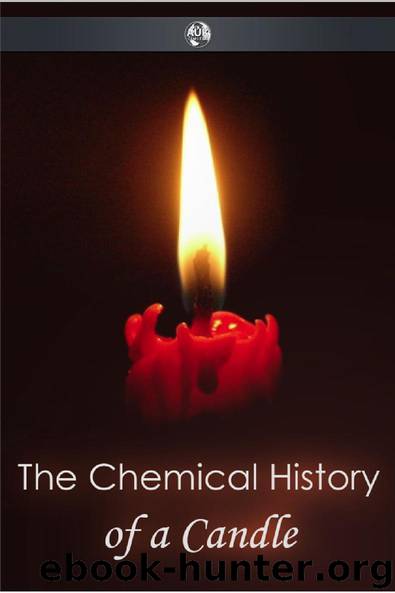The Chemical History of a Candle by Michael Faraday

Author:Michael Faraday
Language: eng
Format: epub
Tags: michael faraday, physics, science, chemistry, lecture, lectures, children's, kids
ISBN: 9781781668191
Publisher: Andrews UK Limited 2012
Published: 2012-06-19T00:00:00+00:00
LECTURE V.
OXYGEN PRESENT IN THE AIR - NATURE OF THE ATMOSPHERE - ITS PROPERTIES - OTHER PRODUCTS FROM THE CANDLE - CARBONIC ACID - ITS PROPERTIES.
We have now seen that we can produce hydrogen and oxygen from the water that we obtained from the candle. Hydrogen, you know, comes from the candle, and oxygen, you believe, comes from the air. But then you have a right to ask me, "How is it that the air and the oxygen do not equally well burn the candle?" If you remember what happened when I put a jar of oxygen over a piece of candle, you recollect there was a very different kind of combustion to that which took place in the air. Now, why is this? It is a very important question, and one I shall endeavour to make you understand: it relates most intimately to the nature of the atmosphere, and is most important to us.
We have several tests for oxygen besides the mere burning of bodies. You have seen a candle burnt in oxygen, or in the air; you have seen phosphorus burnt in the air, or in oxygen; and you have seen iron-filings burnt in oxygen. But we have other tests besides these, and I am about to refer to one or two of them for the purpose of carrying your conviction and your experience further. Here we have a vessel of oxygen. I will shew its presence to you: if I take a little spark and put it into that oxygen, you know, by the experience you gained the last time we met, what will happen; if I put that spark into the jar, it will tell you whether we have oxygen here or not. Yes! We have proved it by combustion; and now here is another test for oxygen, which is a very curious and useful one. I have here two jars full of gas, with a plate between them to prevent their mixing; I take the plate away, and the gases are creeping one into the other. "What happens?" say you: "they together produce no such combustion as was seen in the case of the candle." But see how the presence of oxygen is told by its association with this other substance[14]. What a beautifully coloured gas I have obtained in this way, shewing me the presence of the oxygen! In the same way we can try this experiment by mixing common air with this test-gas. Here is a jar containing air - such air as the candle would burn in - and here is a jar or bottle containing the test-gas. I let them come together over water, and you see the result: the contents of the test-bottle are flowing into the jar of air, and you see I obtain exactly the same kind of action as before, and that shews me that there is oxygen in the air - the very same substance that has been already obtained by us from the water produced by the candle.
Download
This site does not store any files on its server. We only index and link to content provided by other sites. Please contact the content providers to delete copyright contents if any and email us, we'll remove relevant links or contents immediately.
| Arts & Humanities | Health |
| Language Arts | Library Skills |
| Mathematics | Reading & Phonics |
| Science & Technology | Social Studies |
The Art of Coaching Workbook by Elena Aguilar(51075)
Trainspotting by Irvine Welsh(21568)
Twilight of the Idols With the Antichrist and Ecce Homo by Friedrich Nietzsche(18565)
Fangirl by Rainbow Rowell(9173)
Periodization Training for Sports by Tudor Bompa(8209)
Change Your Questions, Change Your Life by Marilee Adams(7683)
This Is How You Lose Her by Junot Diaz(6831)
Asking the Right Questions: A Guide to Critical Thinking by M. Neil Browne & Stuart M. Keeley(5708)
Grit by Angela Duckworth(5554)
Red Sparrow by Jason Matthews(5424)
Paper Towns by Green John(5136)
Room 212 by Kate Stewart(5070)
Ken Follett - World without end by Ken Follett(4682)
Housekeeping by Marilynne Robinson(4391)
The Sports Rules Book by Human Kinetics(4341)
Double Down (Diary of a Wimpy Kid Book 11) by Jeff Kinney(4240)
Papillon (English) by Henri Charrière(4223)
The Motorcycle Diaries by Ernesto Che Guevara(4050)
Exercise Technique Manual for Resistance Training by National Strength & Conditioning Association(4018)
